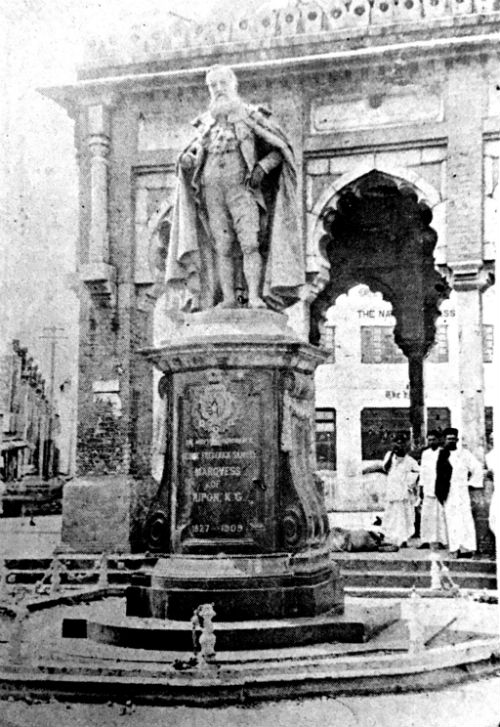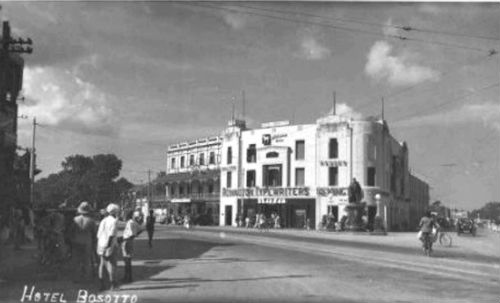Registered with the Registrar of Newspapers for India under R.N.I 53640/91
Vol. XXVII No. 9, August 16-31, 2017
Lost landmarks of Chennai
Sriram V
In memory of ‘Father’ Ripon

Lord Ripon with the Vizianagaram Fountain, Mount Road, in the background
This is a tale of two lost landmarks, well not actually lost one vanished and the other was merely relocated. It is, nevertheless, a story worth recounting.
The intersection of Blacker’s and Mount Roads is best known today for what is known as the Bata Building but which in its time was D’Angelis’, then Bosotto’s, and finally, Airlines Hotel before it became the Durairaj Nadar Complex. It then ‘mysteriously’ caught fire and is now being demolished internally with the façade standing chiefly because the High Court’s judgement regarding heritage buildings has been interpreted to mean protecting just the fronts of such structures. So that too will soon become a lost landmark. Fronting it were the two monuments that are no longer there.
The first of these was the Vizianagaram Maharajah’s fountain. Endowed by Sir Ananda Gajapathi Raju, the Maharajah of Vizianagaram, a man whom Governor M.E. Grant Duff referred to as the Prince Charming of Madras, it was to commemorate Queen Victoria’s Golden Jubilee of Accession, in 1887. This structure, described as “40-foot square, Indo Saracenic in style and topped by a dome” ceased being a fountain by the 1940s and was more of a public latrine with idlers congregating all around it of an evening. Standing as it was in the middle of Mount Road, with Wallajah and Blacker’s Roads leading off it, with Government House on one side, Commissioner J.P.L. Shenoy of the Madras Corporation felt it was time to remove the fountain. The Hindu cried foul, probably because it was Shenoy’s plan to build a public toilet at the spot, but to no avail. The monument was dismantled brick by brick and reassembled in what is described as a “park nearby”. The closest such amenity is Napier’s (May Day) Park but there is no such structure inside it now. The Vizianagaram Fountain is history. Also, no longer standing in London is a similar fountain that the Maharajah constructed in Hyde Park at around the same time. A plaque in Hyde Park, however, commemorates the donation.
Facing the Vizianagaram Fountain and fronting D’Angelis/Bosotto/Airlines Hotel was the statue of Lord Ripon, the one we now see in front of the Corporation headquarters – Ripon Building. It has been there for so long that most researchers have assumed that this was where it was first installed. After all, where else would you expect to find a statue of Lord Ripon but in front of a building named after him? But a closer look will reveal that the statue is not symmetrically located with respect to the handsome edifice. The centrepiece there is Sir Pitti Theagaroya Chetty’s statue, with the one to Ripon’s memory standing on the right and sideways to the building.

The statue at the junction of Mount Road and Blacker’s Road
Ripon’s statue has an interesting history, deserving of a Viceroy who was different in many ways. He was the only Viceroy to be born in 10 Downing Street, for his father Lord Goderich was Prime Minister of England. He was also the only Roman Catholic to be Viceroy of India, serving from 1880 to 1884. He was the only Viceroy to be sworn in at Simla, the hot-weather capital and not in Calcutta. Ripon was the first of two Viceroys to resign midterm (the other being Curzon), leaving India after four, and not the usual five, years. Lastly, unlike many of his predecessors and successors, his departure was the occasion of unprecedented public adulation, all of it from Indians. The European population detested him chiefly because they felt he was conciliatory to Indian aspirations.
Had they only played along with him, Indian history may have been different.
There were many path-breaking legislations under Ripon. First was the repeal of the Vernacular Press Act thereby giving the Indian language Press the same status as the English one. His Local Self Government Act enabled Indians to participate in municipal affairs, thereby taking their first steps in public life. There were other Acts involving Education and Financial Decentralisation, all with a pro Indian slant. His request that the Imperial Civil Services Examinations be held simultaneously in India and England so that more Indians could sit for it was shot down, but he did succeed in enhancing the age limit for the exam from 18 to 21.
The British establishment viewed all these steps with suspicion. It was, however, the Ilbert Bill of 1883, named after Sir C.P. Ilbert, Law Member, Viceroy’s Executive Council, which sought to do away with “Judicial disqualification based on racial discrimination” that brought on British wrath. According to the proposed Bill, Europeans in India could be tried by Indian magistrates and judges. The opposition to the Bill from the officials and powerful business houses ensured Ripon’s resignation. He left India in 1884 but not before experiencing one of the longest farewells ever, being met by deputations of Indians in practically every railway station that his train stopped at between Simla and Bombay. “Ripon Engal Appan” (Ripon is our father) was the cry in Madras. He went on to have a distinguished career in England, retiring from public office only in 1908.
It was therefore no wonder that Indians by and large felt that a memorial of some kind ought to be raised for this most Indian-hearted among Viceroys. But it was a long time in coming. The Congress Party met in Madras in 1903 and passed a resolution requesting a statue. Nothing happened thereafter, but, in 1910, the publisher G.A. Natesan took up the cause. Money was collected. Almost simultaneously, a similar effort was being made in Calcutta. It is noteworthy that in both cases, not a single rupee came from any European. The Indians in Calcutta commissioned the sculptor Francis Derwent Wood to make a bronze statue of Ripon. Those in Madras followed suit. The sculptor was a familiar name here, for his statue of V. Krishnaswami Iyer was already gracing the beachfront.
The Calcutta statue was unveiled by the Viceroy, Lord Hardinge of Penshurst in 1915. Hardinge was another detested figure in that city, for he had planned and executed the shifting of the imperial capital to Delhi. Sir C. Sankaran Nair, by then Member for Education, Viceroy’s Executive Council, got the Governor, Lord Pentland, to unveil the Madras statue. It was installed at the entrance of D’Angelis hotel. The statue remained there till 1939, when increasing congestion in that area forced the Corporation to move it. The Corporation Headquarters, completed in 1913 (and coincidentally inaugurated by the same Lord Hardinge) had been named after Lord Ripon, in gratitude for what he had done for local self government and so it was felt that the statue ought to be located in the same compound. And there it remains. Interestingly, Ripon served as Mayor of his eponymous hometown, long after he had served as Viceroy.
The statue in Calcutta too moved after Independence and now stands in the lawns of the Victoria Memorial. Dotted all over India are other memorials to Ripon. The municipal offices of Multan, now in Pakistan, are housed in a handsome building completed in 1888 and named Ripon Hall. This was renamed after Jinnah in 1948. Riponpet in Shivamugga, Karnataka, and Ripon Street in Kolkata commemorate Ripon too. Mumbai has a Ripon Club, exclusive to Parsis. Kerala has a town called Ripon, located in Wynad.


Pingback: బ్రిటిష్ వాళ్లు ‘ప్రిన్స్ చార్మింగ్’ అన్న తెలుగు రాజావారు ఎవరు? | TRENDING TELUGU NEWS